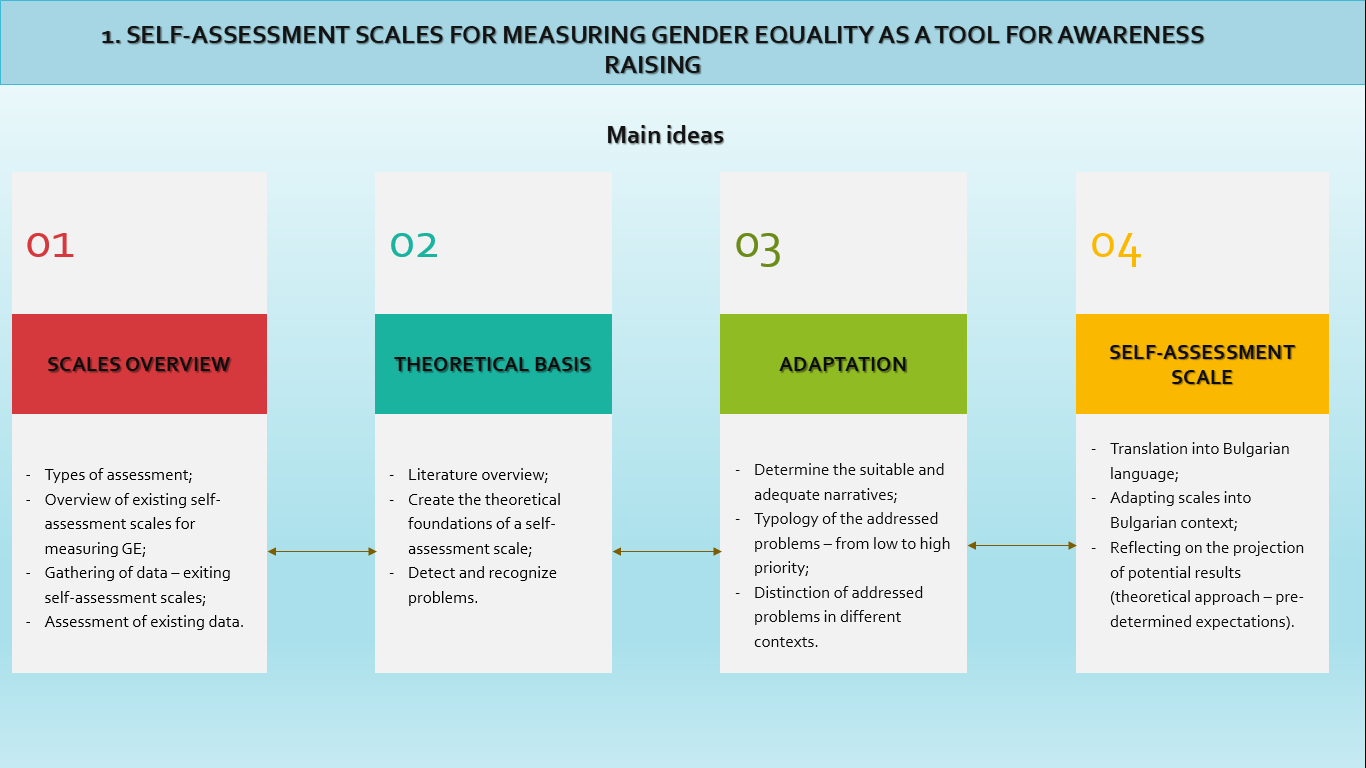After assessing the state-of-play of the institution, we will know which measures need to be implemented.
With this blog, we try to make an overview of existing self-assessment scales for measuring gender equality, as well as to create the theoretical foundations of self-assessment tools that would apply to future GE work of the South-West University team. First and foremost, the tool will serve as a self-assessment of the planned activities and measure the self-reflection and self-evaluation in different activities to establish if they are gendered.

Our main idea regarding awareness-raising is built upon the projection of the usefulness of self-assessment tools and the necessity of a new individual approach in their usage. We think that the results will show us an acceptable way of achieving permanent organizational and individual change in the informativity and reflection regarding gender equality. Our intention aligns with the research of the European Youth Centre at Strasbourg that demonstrates that this kind of feedback is needed to show the necessity of raising awareness, the necessity to speak about equal rights and treatment “no matter the gender, age, race, sexuality and nationality” (Milojevic, Beronja, & Duhacek, 2017: 12).
There are currently many self-assessment tools designed based on theoretical grounds and gathered experiences in various organizations and their gender equality projects (FESTA, TARGET, Gender4STEM, IPPF, EYCS, WHO, etc.). Based on the projects’ thematic approach, the different self-assessment tools inquire on the perception of certain social and organizational spheres and individual attitudes. The existing tools allow gathering data for qualitative and quantitative analysis of the current organizational state, forms of individual and organizational resistance, conscious and unconscious biases and stereotypes, and overall cognitive attitudes on an individual level. According to EIGE, “Quantitative indicators are mostly used to monitor the change statistically and to get an overview on the issues, while qualitative data grasps the experiences and opinions, therefore, understanding the mechanisms behind these issues and capture “the quality of change” (EIGE, 2020). Therefore, practitioners must take into consideration both quantitative and qualitative indicators due to the differentiation in monitoring changes. Data usually shows problematic spheres where the implementation of future measures and actions are needed. Thus, the results from the self-assessment tools will benefit us in facilitating the implementation of GEPs.
Our general idea is related to the search for ways to create a new and alternative approach to the usage of self-assessment tools. We intend to accomplish the latter by combining specific related scientific and organizational tasks such as:
- popularization of the idea with blogs and scientific papers;
- organization of virtual seminars during which the assessment tools will be used;
- discussions with project partners and exchange of experience and good practices.
This first blog aims to establish the conceptual frame of self-assessment scales for measuring gender equality as a tool for awareness-raising. It will be followed by a second one that will reflect on their usage’s main outputs and evaluation. Consequently, the initial stage will deal with introducing our idea by presenting the aims and objectives. The next stage, presented as a second blog, will deal with applying our approach on three-day virtual seminars and gathering empirical data. The seminars’ additional purpose is to raise awareness on GE and familiarize the participants (academic staff members, administrative staff, PhD Students, BA and MA student, stakeholders) with GEPs implementation’s objectives. By doing that we project to achieve specific results both in theory and practice. In a third, separate blog, we will present the main misconceptions in a Bulgarian context concerning gender-sensitive language and apply a critical approach in overcoming them. The third blog will draw some of its conclusions based on the empirical results from the second one.
All of the described activities, which are part of searching and establishing a new and alternative approach in using self-assessment scales, aimed to achieve eight main objectives:
- Establishing an alternative approach towards self-assessment scales’ usage;
- Aim at awareness-raising about the importance of gender equality at SWU;
- Assessment tools adapted into Bulgarian context;
- Typology of misconceptions. Recognizing conscious and unconscious biases;
- Assessment of the existing policies at SWU and whether they meet an acceptable standard of gender equity;
- Awareness raising and critical thinking towards GE topics;
- Awareness raising and determine the misconceptions on GE based on biased concepts and terminology;
- Facilitating the implementation of GEP at SWU.
REFERENCES:
EIGE, 2020. In: https://eige.europa.eu/gender-statistics/dgs
Milojevic, D., Beronja, J.R. & Duhacek, N. (2017). SAGE: Self-Assessment on Gender Equality. European Youth Centre Strasbourg.


